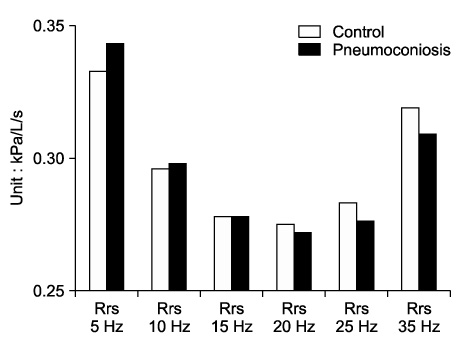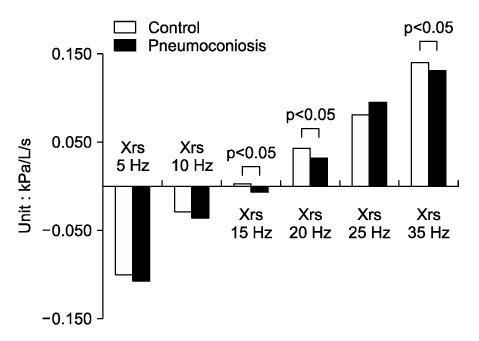Tuberc Respir Dis.
2011 Dec;71(6):431-437.
The Application of Impulse Oscillometry (IOS) in the Workers Who had been Exposed to Inorganic Dust Induced Early Airway Obstruction
- Affiliations
-
- 1Occupational Lung Diseases Institute, Korea Workers' Compensation & Welfare Service (KCOMWEL), Ansan, Korea. ljo9704@naver.com
- 2Korea Occupational Medicial Institute, Uijeongbu, Korea.
Abstract
- BACKGROUND
We tried to examine the small airway diseases which can be found early, in workers exposed to inorganic dusts. This is measured in normal breath by using the impulse oscillometry (IOS).
METHODS
The Pulmonary function test (forced vital capacit [FVC], forced expiratory volume in one second [FEV1], forced expiratory flow between 25% and 75% of vital capacity [FEF25-75]), IOS resistance (Rrs at 5, 10, 15, 20, 25, 35 Hz) and reactance (Xrs at 5, 10, 15, 20, 25, 35 Hz) were measured for 454 workers. The subjects were classified into 173 workers of normal (38.1%) and 281 patients with pneumoconiosis (61.9%).
RESULTS
There were significant differences between normal and patients with FVC (3.82+/-0.61 vs. 3.53+/-0.56 L), FEV1 (2.67+/-0.63 vs. 2.35+/-0.48 L), and FEF25-75 (1.88+/-0.95 vs. 1.47+/-0.80 L/sec) between groups (p<0.05). And as for IOS, there was no significant difference in resistance (Rrs) (p>0.05), and there were significant differences between normal and patients with reactance (Xrs) 15 Hz (0.003+/-0.05 vs. -0.006+/-0.04 kPa/L/s), 20 Hz (0.043+/-0.05 vs. 0.031+/-0.04 kPa/L/s), and 35 Hz (0.141+/-0.05 vs. 0.131+/-0.05 kPa/L/s) between groups (p<0.05).
CONCLUSION
We could find out that 15 Hz, 20 Hz, and 35 Hz values of reactance were significantly influenced by pneumoconiosis. When usefulness and reproducibility to carry out the IOS are considered, it is thought that in future work will be required to draw the reference values for normal Korean persons.
MeSH Terms
Figure
Reference
-
1. Chia KS, Ng TP, Jeyaratnam J. Small airways function of silica-exposed workers. Am J Ind Med. 1992. 22:155–162.2. Bégin R, Ostiguy G, Cantin A, Bergeron D. Lung function in silica-exposed workers. A relationship to disease severity assessed by CT scan. Chest. 1988. 94:539–545.3. Park IN, Hue SH. Bronchial hyperreactivity in subjects with smail airway disease using methacholine bronchial provocation test. Tuberc Respir Dis. 1990. 37:151–159.4. Kim YS, Kweon SH, Song MY, Yoo SM, Park JS, Jee YK, et al. The application of impulse oscillometry (IOS) in the detection of smoking induced early airway obstruction. Tuberc Respir Dis. 1997. 44:1030–1039.5. Dubois AB, Brody AW, Lewis DH, Burgess BR Jr. Oscillation mechanics of lungs and chest in man. J Appl Physiol. 1956. 8:587–594.6. Demedts M, Van Noord JA, Van De Woestijne KP. Clinical applications of forced oscillation technique. Chest. 1991. 99:795–797.7. Oostveen E, MacLeod D, Lorino H, Farré R, Hantos Z, Desager K, et al. The forced oscillation technique in clinical practice: methodology, recommendations and future developments. Eur Respir J. 2003. 22:1026–1041.8. Wouters EF. Total respiratory impedance measurement by forced oscillations: a noninvasive method to assess bronchial response in occupational medicine. Exp Lung Res. 1990. 16:25–40.9. Jorna T, Koiter N, Slangen J, Henderson P, Wouters E, Borm P. Effects of inorganic dust exposure on lung function measured by spirometry and forced oscillation technique (FOT). Am Rev Respir Dis. 1992. 145:A539. (Abstract).10. Pairon JC, Iwatsubo Y, Hubert C, Lorino H, Nouaigui H, Gharbi R. Measurement of bronchial responsiveness by forced oscillation technique in occupational epidemiology. Eur Respir J. 1994. 7:484–489.11. Pham QT, Bourgkard E, Chau N, Willim G, Megherbi SE, Teculescu D, et al. Forced oscillation technique (FOT): a new tool for epidemiology of occupational lung diseases? Eur Respir J. 1995. 8:1307–1313.12. Kim JS, Kim CW, Park JY, Chung HW, Park JW, Hong CS. Clinical usefulness of impulse oscillometry (IOS) in bronchial asthma. Korean J Med. 2000. 59:522–528.13. Park JY, Kim CW, Lee JH, Park YS, Park BG, Park JW, et al. Usefulness of impulse oscillometry in patients with asymptomatic bronchial asthma. J Asthma Allergy Clin Immunol. 2001. 21:491–499.14. Hayes DA, Pimmel RL, Fullton JM, Bromberg PA. Detection of respiratory mechanical dysfunction by forced random noise impedance parameters. Am Rev Respir Dis. 1979. 120:1095–1100.15. Lándsér FJ, Nagles J, Demedts M, Billiet L, van de Woestijne KP. A new method to determine frequency characteristics of the respiratory system. J Appl Physiol. 1976. 41:101–106.16. Peslin R, Duvivier C, Gallina C, Cervantes P. Upper airway artifact in respiratory impedance measurements. Am Rev Respir Dis. 1985. 132:712–714.17. Choi BS, Kim JH, Lee JO, Shin JH. Logical propulsion plan research of pneumoconiosis worker protection business by pneumoconiosis worker graying back. 2006. Gwacheon: Ministry of Labor.18. Wright JL, Harrison N, Wiggs B, Churg A. Quartz but not iron oxide causes air-flow obstruction, emphysema, and small airways lesions in the rat. Am Rev Respir Dis. 1988. 138:129–135.19. Churg A, Hobson J, Wright J. Functional and morphologic comparison of silica- and elastase-induced airflow obstruction. Exp Lung Res. 1989. 15:813–822.20. Choi BS. A study on the development of coalworkers' pneumoconiosis in Korea. 1995. Seoul: Graduate School of Health, Seoul National University.21. van Noord JA, Wellens W, Clarysse I, Cauberghs M, Van de Woestijne KP, Demedts M. Total respiratory resistance and reactance in patients with upper airway obstruction. Chest. 1987. 92:475–480.22. Severinghaus JW. Blood gas calculator. J Appl Physiol. 1966. 21:1108–1116.23. Peslin R, Marchal F, Duvivier C, Ying Y, Gallina C. Evaluation of a modified head generator for respiratory impedance measurements. Eur Respir Rev. 1991. 1:140–145.24. Park JS, Kim YS, Choi EK, Jee YK, Lee KY, Kim KY, et al. Effect of exercise on pulmonary function. Tuberc Respir Dis. 1998. 45:351–359.25. Keman S, Willemse B, Wesseling GJ, Kusters E, Borm PJ. A five year follow-up of lung function among chemical workers using flow-volume and impedance measurements. Eur Respir J. 1996. 9:2109–2115.
- Full Text Links
- Actions
-
Cited
- CITED
-
- Close
- Share
- Similar articles
-
- The Application of Impulse Oscillometry(IOS) in the Detection of Smoking Induced Early Airway Obstruction
- A comparison between impulse oscillometry system and spirometry for spirometry for detecting airway obstruction in children
- Relationship between exhaled nitric oxide and small-airway dysfunction in children with asthma using spirometry and the impulse oscillometry system
- Reference values for respiratory system impedance using impulse oscillometry in school-aged children in Korea
- Impulse oscillometry as a method measuring airway resistance



